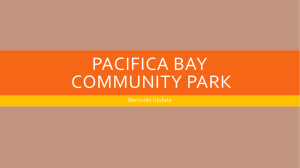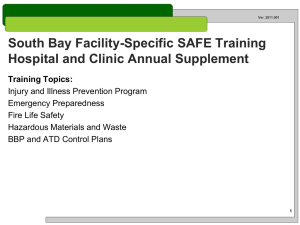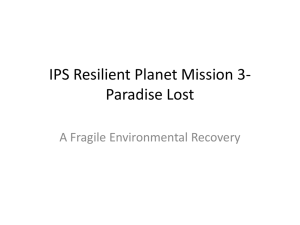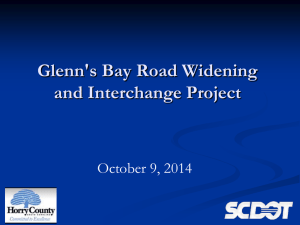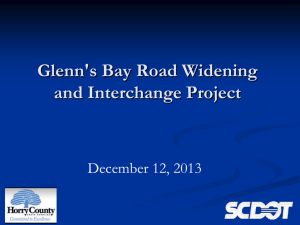samir
advertisement
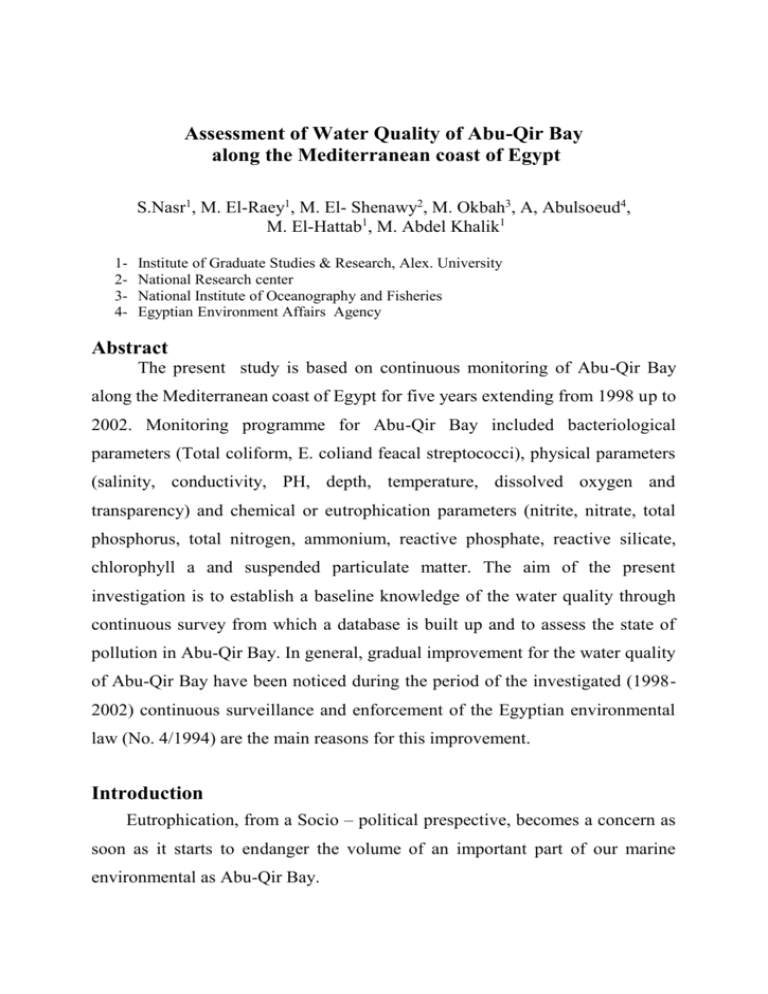
Assessment of Water Quality of Abu-Qir Bay along the Mediterranean coast of Egypt S.Nasr1, M. El-Raey1, M. El- Shenawy2, M. Okbah3, A, Abulsoeud4, M. El-Hattab1, M. Abdel Khalik1 1234- Institute of Graduate Studies & Research, Alex. University National Research center National Institute of Oceanography and Fisheries Egyptian Environment Affairs Agency Abstract The present study is based on continuous monitoring of Abu-Qir Bay along the Mediterranean coast of Egypt for five years extending from 1998 up to 2002. Monitoring programme for Abu-Qir Bay included bacteriological parameters (Total coliform, E. coliand feacal streptococci), physical parameters (salinity, conductivity, PH, depth, temperature, dissolved oxygen and transparency) and chemical or eutrophication parameters (nitrite, nitrate, total phosphorus, total nitrogen, ammonium, reactive phosphate, reactive silicate, chlorophyll a and suspended particulate matter. The aim of the present investigation is to establish a baseline knowledge of the water quality through continuous survey from which a database is built up and to assess the state of pollution in Abu-Qir Bay. In general, gradual improvement for the water quality of Abu-Qir Bay have been noticed during the period of the investigated (19982002) continuous surveillance and enforcement of the Egyptian environmental law (No. 4/1994) are the main reasons for this improvement. Introduction Eutrophication, from a Socio – political prespective, becomes a concern as soon as it starts to endanger the volume of an important part of our marine environmental as Abu-Qir Bay. For all practical purposes therefore, a simple definition has been adopted that tolds eutrophication to be a form of nutrient pollution that degrades and endangers a natural resources of our marine environment, so eutrophication is considered to be a symptom of pollution, where by addition of excess nutrients lead to excess growth of algae with perhaps leading to high mortality of heterotraphic organisms, particularly fish and benthic organisms. Thus to most people eutrophic marine environment seems to mean striking change in an ecosystem due to addition of nutrients from a variety of human activities. Harmful impact of eutrophication which is related to beneficial uses, namely: - The reduction of tourist – recreational value of coastal water due to reduced transparency, changes in the color of seawater, phytoplankton blooms and modified shore communities ….. etc. - Health effects of algal toxic extra metabolites, directly or by accumulation in sea-food organisms. - The loss of fisheries resources, mainly as: Mass mortalities of demersal fish and invertebrates. Reduced or collapsed recruitment of inshore, estuarine and tidal lagoon fish and shellfish. Hindrance of aquaculture and / or inquiring the quality of its product, In Abu-Qir Bay, eutrophication in superficial waters results from several phenomena which are winter vertical mixing of water, discharge of effluents (River Nile, domestic, agricultural and industrial effluents) and natural terrestrial run off. The environmental information monitoring programme for Abu-Qir Bay in its sampling design was stressed the measurement at major industrial settlement along the Bay, coastal communities i.e. Abu-Qir city, Maadia, Idku and Rashid villages, river Nile estuary at Rosetta. and outlet of lake Idku. In general sources of pollution in Abu-Qir Bay are industrial, agricultural and domestic The main target for the environmental information monitoring programme of Abu-Qir Bay is to establish a baseline knowledge of the water quality through continuous survey from which a database is built up. The results of this study will be used to establish quantitive and causal relations between pollution sources and pollution impact. Study area Abu-Qir Bay is a semi-circular basin which lies at about 35 km northeast of Alexandria city, between longitude 300 4’ and 300 20’ East and latitude 310 16’ and 310 28’ North, (Fig.ure 1). Its total area is about 500 km2. The bay has a shoreline length of about 50 km. It is relatively shallow with a depth ranging from less than one meter along the coast, increasing gradually away from the shore to reach a maximum depth of about 15m. The slope of the beach is gentle backed by a belt of and dunes. The bay is bordered from the west by Abu-Qir Peninsula and from the East by Rosetta Peninsula where the Rosetta branch of the River Nile flows into the sea. Bottom sediment distribution of Abu-Qir Bay is affected mainly by the discharge of Rosetta branch of the River: The bottom of the eastern past of the bay is of a muddy nature due to the large quantities of mud discharged annually through the Rosetta branch (2 to 5 x 10 9 m3) (Academy of Scientific Research and Technology, ASRT, 1984). Abu-Qir Bay is exposed to industrial and agricultural waste, discharged through El-Tabia outfall, Maadia outlet and the Rosetta branch of the Nile River. Several studies have dealt with heavy metal distribution in Abu-Qir Bay, (e.g. ASRT, 1984; Saad et al., 1981; Toma et al., 1981; and Emara, 1983). Distributions of DDT, Alpha Benzene Hexachloride (α – BHC ), Lindane and bottom sediment are also studied (ASRT, 1984). Geographic information system analysis for sediments, heavy metals and pesticides in Abu-Qir Bay have been carried out by Nasr et. al. 1997. Water quality of Egyptian Mediterranean coastal water including Abu-Qir Bay have been done by Haslund et. al. 1999 and El-Iskandarani et. al. 2003. Sources and types of pollution in Abu-Qir Bay are summarized in Table (1). Table 1. Sources of various pollutant in Abu-Qir Bay: Source Types of pollution, (ASRT, 1984 Rate of Discharge and Said, 1989) El-Tabia Outfall Food processing and canning, 1.5-2 million m3/day, paper industry, fertilizers industry (ASRT, 1984) and textiles manufacturing. Maadia outlet of Idku Lagoon Drainage water from agricultural 1.5-2 million m3/day, usually contains pesticides. (WAHBY and ElDEEB, 1983) Rosetta branch of Fresh water discharged carries 2-5 x 109 m3/year, the River Nile agricultural waste from cultivated (El-HEHYAWI, lands. 1984) Materials and Methods - Basic parameters: These include depth and vertical profile of salinity, specific conductivity, temperature, pH and dissolved oxygen (DO) and water transparency (Secci disc). CTD (YSI) was used for measuring the physical parameters. - Bacteriological parameters (total coliform, faecal coliform and faecal streptococci). Special rode with glass carrier has been used for collection of samples. Eutrophication parameters: These include total suspended matter (SPM), nitrate, nitrite, ammonia, total nitrogen, total phosphorus, silicate and chlorophyll-a. Inflatable rubber boat (Zodiac) with engine 30 horse, and Rotteners bottle were used for collection of water sample for the different cruises. 4 WD car with trailer for the rubber boat and a laboratory van equipped with filtration system and the required equipment for the performing the field analysis were used to execute the field work. Basic Parameters Conductivity, Salinity, pH, depth, water temperature and Dissolved oxygen were Measured using 600XL Multi-parameter water Quality Monitor (CTD) YSI incorporated. The data stored in the field in YSI 610 microcomputer (Data logger) and transferred to the laboratory computer using powerful software (PC6000). Bacteriological Parameters Sampling techniques, preparation, handling and preservation of marine water sample were done according to the guidance described in the International Organization for standardization (ISO) No. 5667/9 (1992). Detection and enumeration of coliform organisms and presumptive E. coli were done using method and media described in the International Organization for Standardization (ISO) No. 9308-1 (1990) whereas feacal streptococci bacteria were detected and enumerated according to International Standardization (ISO) No. 7899/2 (1984). Organization for Eutrophication Parameters Six stations were selected to represent Abu-Qir Bay (Figure 1). Water samples were collected at depth of about 2.5 m from the surface. The samples were filtered through filter paper (GF/C). The dissolved inorganic nutrient salts (including nitrite, nitrate, ammonia, phosphate and silicate) were analyzed spectro-photometrically or by using Alpakam auto analyzer for NO2, NO3, P, and Si. The determination of nitrite (NO2) was carried out according to Grasshoff (1983a). The determination of nitrate (NO3) was carried out according to Grasshoff (1983b). Total method used for determination of total nitrogen and total phosphorous was performed according to Valderrama (1981). The method used for determination of ammonia was conducted according to Koroleff (1983a). The method used for determination of reactive phosphate was carried out according to Koroleff (1983b). Determination of reactive silicate was performed according to the method described by Koroleff (1983). Chlorophyll-a extraction and measurement was performed according to Strickland and parasons (1972). Suspended particulate matter was measured according to the method described by van loon (1982). RESULTS AND DISCUSSION Bacteriological investigation for pathogenic bacteria (Total coliforms, E. coli and feacal Streptococci) in Abu-Qir Bay during the last five years (1998 – 2002) revealed the following: The sites especially in form of outlets like Maadia, Rosetta and outfalls were contaminated by feacal pollution indicators bacteria with counts exceeded the acceptable numbers adopted by the European Communities standards (ECS). In general Idku (Site Me 26) did not exceed the permissible numbers during most of monitoring campaigns. Feacal contamination found in Abu-Qir Bay is due to discharge of untreated Sewage water in the bay. Discharging the wastewater into the sea consider a potential reservoir of risk to public health through direct infection to swimmers and / or eating contaminated sea-food. Monitoring of physical parameters during 1998 revealed that salinity was low in front of fresh water outlets like Media (Me 25) and Rashid (Me31)-With respect to pH values, slightly alkaline values were recorded for Abu-Qir Bay. Low values of dissolved oxygen were observed sometimes in the Bay. Relatively higher water temperature was observed most of the time in front of Electrical Power Station of Abu-Qir Bay (Me 23). This is due to cooling water of power station discharged into the bay. This phenomenon was continued during the investigation years (from 1998 – 2002). In 1999, relatively wide variation of temperature values were recorded in May at Rashid. The higher DO values were detected in surface water of the Maadia (Me 25) during May. This is due to the high rate of mixing and presence of strong surface currents. Sometimes is due to the presence of high amount of phytoplankton causing photosynthesis which lead to increase of DO. While the lower DO values were recorded during 1999 in the deep water of Abu-Qir Bay at stations Me 21, Me 23 and Me 25. This could be attributed to the discharge of untreated wastewater into the bay through Maadia outlet, Tabia outfall plus cooling water from the Electrical Power Station. The lower salinities were observed in front of Electrical Powers Station (Me 23), Maadia (Me 25) and Rashid (Me 29) during the campaigns of the year 1999. With respect to transparency, Maadia was one of the most turbid stations during the year 1999. The investigation of sea water temperature during year 2000 revealed thermal pollution was detected in Abu-Qir Bay in front of Electrical Power Station (Me 23) especially in summer and autumn seasons. Relatively lower salinity values were observed at Rashid (Me 29, 31). Investigation of dissolved oxygen (DO) during year 2000 in Abu-Qir Bay revealed that, two cases of DO deficiency have been detected, the first one was below the Egyptian guideline (4 mg/l) and the second was hypoxia (> 3 mg/l). Deficiency of DO (> 4 mg/l) has been detected during May 2000 at Abu-Qir Bay (Me 21, 23 and 25). Also during July 2000 at eastern of Abu-Qir city (Me 21) and finally during November at Maadia. Hypoxia (< 3 mg/l DO) has been detected in bottom water of Maadia during May 2000 and during Sept.2000 at Electrical Power Station (Me 23) and Maadia Me 25), and finally during November at eastern Abu-Qair City (Me 21) and Electrical Power Station (Me 23). With respect to transparency, the most turbid station was Maadia (Me 25) as the year 1999. Abu-Qir Bay was considered as one of the sites which has relatively higher average values of sea water temperature through out of the year 2001. In particular, Electrical Power Station (Me 23) is one of the most important hot spot of thermal pollution overall the Egyptian Mediterrances coast. Relatively, lower salinity values was observed as usual in front of outlets like Maadia (Me 25) and River Nile like Rashid (Me 29, 31) during the year 2001. It is worthy to mention that the River Nile did not contribute to decrease salinity in front of Rashid (Me 29, 31) during March and May 2001. This is due to the change of seawater current to be from sea towards Rashid estuary. Hypoxia was recorded during 2001 in Abu Qir Bay at eastern Abu-Qir City (Me 21) Electrical Power Station (Me 23) and Maadia (Me 25). In 2002 all the detected pH values were slightly alkaline and their variation were within the normal range of seawater. The investigation of seawater salinity during 2002 revealed that the lower salinity values were detected at Electrical Power Station (Me 23), El-Maadia (Me 25) and Rashid (Me 29, 31). With respect to DO, hypoxia has been detected during May 2002 at eastern Abu-Qir city (Me 21). Moreover, during Sept. 2002, hypoxia and water stratification have been detected in deep water of El-Maadia (Me 25). This is due to receiving polluted water from Maadia outlet. As usual, Maadia was the most turbid station along Abu-Qir Bay during 2002. Moritoring of eutrophication parameters i.e. nitrite, nitrate, ammonia, phosphorous, silica, chlorophyll-a and SPM at Abu Qir during 1998 revealed high levels at eastern Abu Qir City (Me 21), Electrical Power Station (Me 23), El-Maadia outlet (Me 25) and Rashid (the 29 and 31). Those high levels were due to discharge of untreated wastewater into Abu-Qir Bay (Haslund et. al., 1999; El-Iskandarani et. al., 2003). With respect to eutrophication parameters, improvement in water quality has been noticed at Abu-Qir Bay during 1999 if compared with 1998. During year 2000, the regional and bimonthly variations of nitrate and nitrite along Abu-Qir Bay showed relatively low levels during the whole period of investigation except in Sept. at Electrical Power Station where the nitrite was relatively high. Ammonia showed relatively less levels compared to the year 1999. High level of dissolved inorganic nitrogen (DIN) were estimated at Abu-Qir Bay (Me 20, 21 and 23). It were reached to half of total nitrogen in July 2000. This may be due to the impact of discharge of domestic, industrial and agricultural runoff into the bay. Normal levels were observed for phosphate, silicate, SPM and chlorophyll-a during 2000 (Haslund et. al., 1999; El-Iskandarani et. al. 2003). In the year 2001, relatively low levels of nitrate and nitrite were recorded at Abu-Qir Bay, while high concentration of total nitrogen was observed at eastern Abu-Qir City (Me 21). This is due to the impact of discharge of untreated wastewater into the bay. Moreover, normal levels of reactive phosphate and dissolved inorganic nitrogen (DIN) were recorded at Abu-Qir Bay during 2001. Relatively, high levels of chlorophyll-a and suspended matter were observed in front of outlets like El-Maadia (Me 25) and Rashid estuary (Me 31). During 2002, Maadia (Me 25) and Rashid (Me 31) were characterized by increasing primary production (relatively high levels of chlorophyll-a). This may be related to the influence of drainage water brought by the River Nile or industrial wastewater like Electrical Power Station or mix of industrial and agricultural wastewater like Maadia (Me (25). The results of nitrite showed low levels during the whole period of investigation. High concentrations of dissolved inorganic nitrogen (DIN) were recorded at Electrical Power Station and Maadia during 2002. Moreover relatively high silicate was observed at Maadia (Me 25) and Rashid (Me 29 and 31). In general gradual improvement for water quality of Abu-Qir Bay have been noticed during the period of the investigation (1998-2002). Continuous surveillance and enforcement of the Egyptian environmental law No. 4/94 are the main reasons for this improvement. Acknowledgement: The authors highly acknowledge and deeply appreciate the technical and financial supports of EEAA, DANIDA and SMART project for completion of the present investigation. List of References - (ASRT), Academy of Scientific Research and Technology, (1984). Investigation of level effect of pollutants in saline lakes and littoral marine environments. Institute of Oceanography and Fishers (Mediterranean Branch). Final Report of pollution status of Abu-Qir Bay, Alexandria. 166p. - El-Gindy, A.A.,; Shereet, H. and El-Skiekh, S.,1991. Circulation and water masses and their implication on pollutant transport during summer in Abu-Qir Bay (Egypt). Journal of Qatar University of Science, 11, pp. 379-390. - El-Hehyawi, M.L., (1984). Effect of pollution on the fishery ground adjacent to Alexandria. Bulletin of institute of Oceanography and Fihers (Egypt), 10, pp. 13-23. - Emara, I.H., (1983). Study of some heavy metals in Abu-Qir Bay and Lake Idku. 6th Workshop on pollution of the Mediterranean (Cannes, 2-4 December 1982), pp. 396-400. - El-Iskandarani, M., Nasr, S., Okba, M. and Jansen, A. (2003) Principal component analysis for quality Assessment of Mediterranean coastal water of Egypt. Jour. Association for Advancement of modeling and simulation techniques in enterprises (AMSE), France. - Grasshoff, K. (1983a) Determination of nitrite. In “Method of sea water analysis” eds: K. Grasshoff, M. Ehrhardt, K. Kremling. Verlag. Chemie, pp. 139-142. - Grasshoff, K. (1983b) Determination of nitrite. In “Method of sea water analysis” eds: K. Grasshoff, M. Ehrhardt, K. Kremling. Verlag. Chemie, pp. 143-150. - Halund, O.H., Jenen, A., Nasr, S., Poulen, E., Boisen, F., Ebrahim, A.M.M., El-Seoud, A.A., El-Raey, M., El-Shanawy, M.A., El-Gamal, A., El-Aziz, M.A.(1999). First result from the Egyptian coatal water monitoring programme,, MEDCOAST 99, Nov. 9-13, 1999, Italia, Turkey pp: 1337-1350. - ISO (International Organization for Standardization) No. 5667-9 (1992) water quality – Sampling – part 9: Guidance on sampling from marine waters. Geneva, Switzerland. - ISO (International Organization for Standardization) No. 9308-1 (1990) water quality – Detection and enumeration of coliform organisms, thermotolerant coliform organisms and presumptive Escherichia coli – Part 1 : Membrane filtration method. Geneva, Switzerland. - ISO (International Organization for Standardization) No. 7899/2 (1984) water quality – Detection and enumeration of faecal streptococci – Part 2 : Methods by membrane filtration. Geneva, Switzerland. - Koreleff, F. (1983a) Determination of Ammonia. In “Method of sea water analysis” eds: K. Grasshoff, M.Ehrhardt, K. Kremling. Verlag. Chemie, pp. 150-157. - Koreleff, F. (1983b) Determination of dissolved inorganic phosphate. In “Method of sea water analysis” eds: K. Grasshoff, M. Ehrhardt, K. Kremling. Verlag. Chemie, pp. 125-130. - Koreleff, F. (1983c) Determination of Silicon. In “Method of sea water analysis” eds: K. Grashoff, M. Ehrhardt, K. Kremling. Verlag. Chemie, pp. 174-184. - Moussa, A.A., (1983). Trace elements in recent sediments of the Nile Delta continental shelf: Their accumulation and significance. 6 th Workshop on pollution of the Mediterranean (Cannes, 2-4 December 1982). Pp. 401-404. - Nasr, S., El-Raey, M., Ezzat, H., and Ibrahim, A., (1997). Geographical Information system Analysis for sediments, Heavy metals and pesticides in Abu-Qir Bay, Egypt. Journal of Coastal Reearch. No. 13. V. 4, pp: 1233-1237. - Strickland, J.D. and Parson, T.R. (1972). A practical handbook of sea water analysis. Bull. Fish. Res. Bd. Canada, Ottawa, No. 167. - Saad, M.A.H,; El-Rayis, and El-Nady, F.F., 1981. Occurrenvce of some trace metal in bottom deposits from Abu-Qir Bay, Egypt. 5th Workhop on pollution of the Mediterranean (Cagliari, 9-13 October 1980), pp. 555560. - Said, M.A., 1989. Marine pollution of Abu-Qir Bay. Journal of the Arab Marine Academy, 144, pp. 27-29. - Toma, S.A.; Saad, M.A.H.; Salama, M.S. and Halim, Y., (1981). The distribution of some adsorbed elements on the Nile continental shelf sediment. 5th workshop on pollution of the Mediterranean (Cagliari, 9-13 October 1980) pp. 377-382. - Valderrama, J.C. (1981). Mar. Chem. 10, pp. 109-120. - Van Loon, J.C. (1982). Chemical analysis of inorganic constituents of water. CRC Press, Inc. Boca Raton, Plorida, 226 p. - Wahby, .D. and El-Deeb, K.Z., (1983). The effect of land- based out-falls on the level of phosphorous in Abu-Qir Bay. 6th Workshop on pollution of the Mediterranean (Cannes, 2-4 December 1982), pp. 509-514.

![[Company Name] Certificate of Completion](http://s2.studylib.net/store/data/005402466_1-8a11f4ced01fd5876feee99f8d8e6494-300x300.png)
